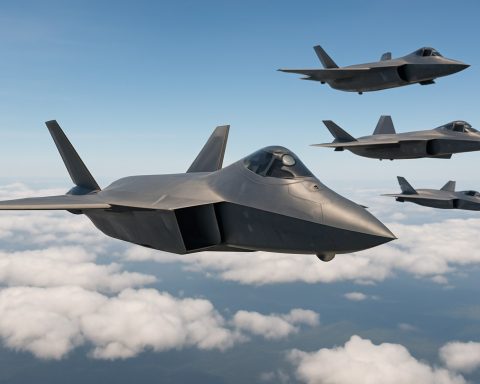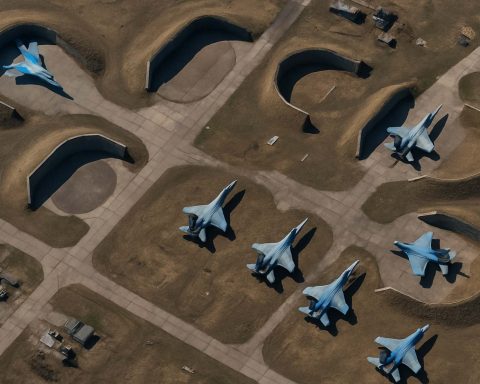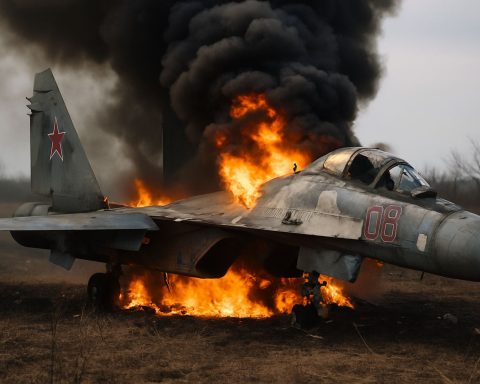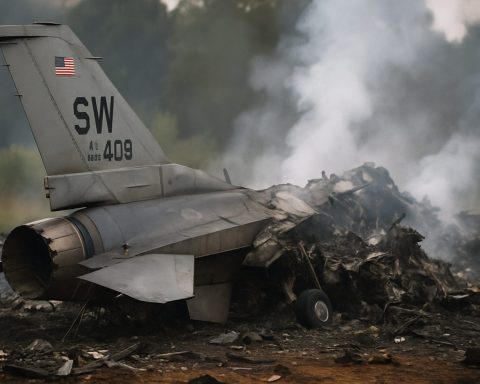- The Su-34 fighter-bomber, engineered by United Aircraft Corporation, showcases Russia’s technological resilience amid international sanctions.
- Known to NATO as “Fullback,” the Su-34 features a twin-engine design and side-by-side cockpit, offering speed, agility, and potent firepower.
- Production has surged, with Rostec reporting a doubling in the past two years despite geopolitical constraints, reflecting Russian determination.
- The Su-34 excels in high-threat environments with advanced avionics and self-defense systems, comparable to Western equivalents like the F-15E and Tornado IDS.
- Vladimir Artyakov highlights the Su-34’s crucial role in the Russia-Ukraine conflict, emphasizing its operational efficiency and maneuverability.
- The aircraft symbolizes innovation and strategic focus, underscoring Russia’s commitment to maintaining air superiority.
In the vast expanse of Russia’s military airfields, the sleek silhouette of a newly delivered Su-34 fighter-bomber glistens under overcast skies, a testament to the nation’s unyielding resolve. As the Su-34, known as the “Fullback” to NATO, taxis onto the runway, its presence speaks volumes—not only of its formidable capabilities but of a broader narrative in the world of military aviation.
Engineered by the United Aircraft Corporation, the Su-34 offers a formidable blend of speed, agility, and firepower. With a twin-engine design and a distinctive side-by-side cockpit configuration, it resembles a predatory raptor, poised for attack. This strike fighter doesn’t merely soar above; it conquers, with an arsenal capable of engaging targets ranging from fortified ground positions to highly defended aerial threats.
Against the backdrop of international sanctions, aiming to crimp Russia’s access to global technologies, the Su-34 emerges as a symbol of defiance and adaptation. Russian defense conglomerate Rostec reported that despite the geopolitical chokehold, production of these advanced aircraft has not only continued but surged—more than doubling in the last two years. To watch one of these craft lift off is to witness a feat of engineering that defies the odds set by economic constraints.
The Su-34’s reputation as a cornerstone of Russia’s frontline aviation is not lightly earned. Designed to operate in high-threat environments, its robust self-defense systems and advanced avionics enable it to thrive where others might falter. Like its Western counterparts, the F-15E Strike Eagle and the Tornado IDS, the Su-34 excels in long-range strikes with precision-guided munitions. However, its unique blend of agility and firepower sets it apart as a versatile platform within the fourth-generation-plus aircraft—a steadfast asset in an unpredictable theater of war.
Vladimir Artyakov of Rostec underscored its importance, revealing the fighter’s pivotal role in the ongoing Russia-Ukraine conflict. Artyakov’s emphasis on the Su-34’s high efficiency and exceptional maneuverability reaffirms its status as a key player in fulfilling critical operational tasks, cementing its place in Russia’s strategy to maintain air superiority.
Even in the face of sanctions, Russian ingenuity finds a way. The relentless pace of Su-34 production underscores how innovation coupled with determination can overcome external pressures. As each aircraft completes its rigorous factory acceptance tests, it is clear that Russia’s strategic focus remains fixed on reinforcing its aerial dominance.
The skies over Ukraine, and indeed, the world, now bear witness to a new chapter in aerial combat. The continued deployment of Su-34 fighter-bombers signals a relentless pursuit of military might, an enduring message that despite global attempts to stifle its progress, the Russian aerospace landscape remains resolutely ascendant. The Su-34’s ascent is more than just a technological triumph; it is a statement, loud and unfaltering, echoing through the corridors of global power dynamics.
Why the Su-34 Fighter-Bomber is a Game-Changer in Modern Warfare
Overview of the Su-34 Fighter-Bomber
The Su-34 “Fullback” is at the forefront of Russian military aviation, combining cutting-edge technology with robust combat capabilities. The design, featuring a twin-engine and a unique side-by-side cockpit configuration, allows for exceptional agility. This setup not only enhances pilot coordination but also improves the aircraft’s operational effectiveness in complex tactical scenarios.
Key Features and Specifications
– Speed and Performance: The Su-34 is capable of speeds up to Mach 1.8, which enables rapid response and repositioning during missions.
– Avionics: The advanced avionics suite is equipped to support electronic warfare, target acquisition, and precision strike capabilities, making it adaptable to various combat environments.
– Armament: The Fullback can carry a wide array of weapons, including air-to-ground missiles, anti-ship missiles, and precision-guided bombs, providing versatile engagement options against both ground and maritime targets.
How the Su-34 Enhances Operational Capabilities
– Multi-Role Functions: The Su-34 excels not only in ground attacks but also in electronic warfare and reconnaissance roles. It’s designed to perform a variety of missions, from strategic bombing to tactical troop support.
– Self-Defense Systems: Robust self-defense mechanisms, including radar jammers and countermeasures, significantly enhance the aircraft’s survivability.
– Long-Range Operations: With capabilities for in-flight refueling, the Su-34 can conduct extended missions beyond its native airspace, increasing Russia’s strategic reach.
Comparison with Western Counterparts
– Versatility vs. Specialization: While Western aircraft like the F-15E Strike Eagle excel in specific roles, the Su-34’s design emphasizes versatility, allowing it to adapt quickly to diverse mission requirements without significant reconfiguration.
– Geopolitical Impact: In light of economic sanctions, the continued development and deployment of the Su-34 underscore Russia’s resilience and capacity for innovation in military technology.
Market and Industry Insights
– Production Trends: According to Rostec, production of the Su-34 has more than doubled in recent years, a testament to the aircraft’s strategic importance in Russia’s defense planning.
– Global Defense Market Influence: The Fullback’s deployment is likely to influence global defense market trends, prompting other nations to reconsider the robustness and adaptability of their aerial fleets.
Challenges and Controversies
– Sanctions and Supply Chain Issues: International sanctions have challenged Russia’s access to certain advanced components, forcing reliance on domestically sourced technologies.
– Regional Security Concerns: The Su-34’s deployment in volatile regions has raised concerns among neighboring countries regarding regional stability and power dynamics.
Future Prospects and Predictions
– Technological Advancements: Continued upgrades in avionics, weaponry, and stealth capabilities are expected, enhancing the Su-34’s performance and extending its operational lifespan.
– Impact on Global Military Tactics: As more nations develop or enhance similar multi-role platforms, aerial combat strategies are likely to evolve, emphasizing flexibility and rapid adaptability.
Actionable Recommendations
1. Stay Informed: For those in the defense industry, keeping abreast of developments in Russian military aviation can provide strategic insights into global military trends.
2. Evaluate Defense Postures: Countries facing potential security concerns from advanced aircraft like the Su-34 should consider upgrading their detection and response systems.
3. Foster Innovation: Encourage domestic research and development initiatives to reduce reliance on international components and technology transfers.
For more information on cutting-edge aviation technology, visit United Aircraft Corporation and Rostec.
Understanding the Su-34’s capabilities and strategic implications offers valuable insights into the future of aerial warfare and the shifting dynamics of global military power.







